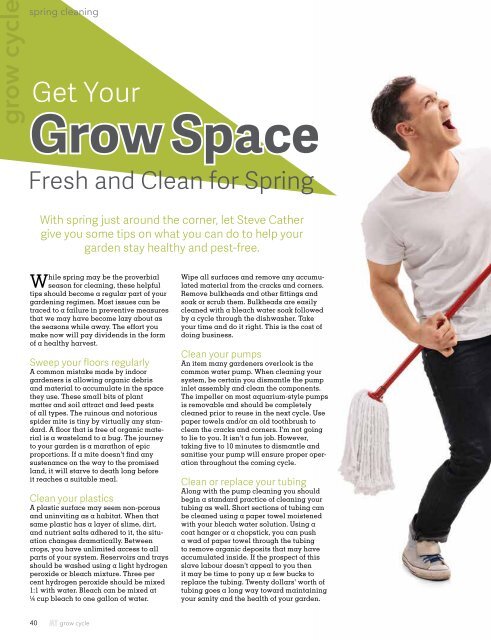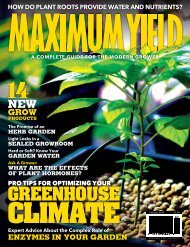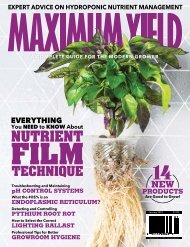Maximum Yield Modern Growing | UK EU Edition | May June 2017
In this issue of Maximum Yield, we cast a wide net to bring you the best and latest information possible to help you get started growing your own food. From the basics like cleaning your equipment to the best methods for preparing your plants to live outdoors, to more advanced topics like lighting and nutrient delivery, there is something in this issue for all levels of grower.
In this issue of Maximum Yield, we cast a wide net to bring you the best and latest information possible to help you get started growing your own food. From the basics like cleaning your equipment to the best methods for preparing your plants to live outdoors, to more advanced topics like lighting and nutrient delivery, there is something in this issue for all levels of grower.
You also want an ePaper? Increase the reach of your titles
YUMPU automatically turns print PDFs into web optimized ePapers that Google loves.
grow cycle<br />
spring cleaning<br />
Get Your<br />
Grow Space<br />
Fresh and Clean for Spring<br />
With spring just around the corner, let Steve Cather<br />
give you some tips on what you can do to help your<br />
garden stay healthy and pest-free.<br />
While spring may be the proverbial<br />
season for cleaning, these helpful<br />
tips should become a regular part of your<br />
gardening regimen. Most issues can be<br />
traced to a failure in preventive measures<br />
that we may have become lazy about as<br />
the seasons while away. The effort you<br />
make now will pay dividends in the form<br />
of a healthy harvest.<br />
Sweep your floors regularly<br />
A common mistake made by indoor<br />
gardeners is allowing organic debris<br />
and material to accumulate in the space<br />
they use. These small bits of plant<br />
matter and soil attract and feed pests<br />
of all types. The ruinous and notorious<br />
spider mite is tiny by virtually any standard.<br />
A floor that is free of organic material<br />
is a wasteland to a bug. The journey<br />
to your garden is a marathon of epic<br />
proportions. If a mite doesn't find any<br />
sustenance on the way to the promised<br />
land, it will starve to death long before<br />
it reaches a suitable meal.<br />
Clean your plastics<br />
A plastic surface may seem non-porous<br />
and uninviting as a habitat. When that<br />
same plastic has a layer of slime, dirt,<br />
and nutrient salts adhered to it, the situation<br />
changes dramatically. Between<br />
crops, you have unlimited access to all<br />
parts of your system. Reservoirs and trays<br />
should be washed using a light hydrogen<br />
peroxide or bleach mixture. Three per<br />
cent hydrogen peroxide should be mixed<br />
1:1 with water. Bleach can be mixed at<br />
¼ cup bleach to one gallon of water.<br />
Wipe all surfaces and remove any accumulated<br />
material from the cracks and corners.<br />
Remove bulkheads and other fittings and<br />
soak or scrub them. Bulkheads are easily<br />
cleaned with a bleach water soak followed<br />
by a cycle through the dishwasher. Take<br />
your time and do it right. This is the cost of<br />
doing business.<br />
Clean your pumps<br />
An item many gardeners overlook is the<br />
common water pump. When cleaning your<br />
system, be certain you dismantle the pump<br />
inlet assembly and clean the components.<br />
The impeller on most aquarium-style pumps<br />
is removable and should be completely<br />
cleaned prior to reuse in the next cycle. Use<br />
paper towels and/or an old toothbrush to<br />
clean the cracks and corners. I'm not going<br />
to lie to you. It isn't a fun job. However,<br />
taking five to 10 minutes to dismantle and<br />
sanitise your pump will ensure proper operation<br />
throughout the coming cycle.<br />
Clean or replace your tubing<br />
Along with the pump cleaning you should<br />
begin a standard practice of cleaning your<br />
tubing as well. Short sections of tubing can<br />
be cleaned using a paper towel moistened<br />
with your bleach water solution. Using a<br />
coat hanger or a chopstick, you can push<br />
a wad of paper towel through the tubing<br />
to remove organic deposits that may have<br />
accumulated inside. If the prospect of this<br />
slave labour doesn't appeal to you then<br />
it may be time to pony up a few bucks to<br />
replace the tubing. Twenty dollars' worth of<br />
tubing goes a long way toward maintaining<br />
your sanity and the health of your garden.<br />
40 grow cycle


















